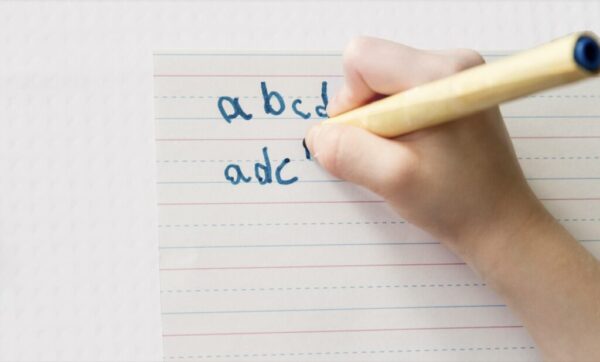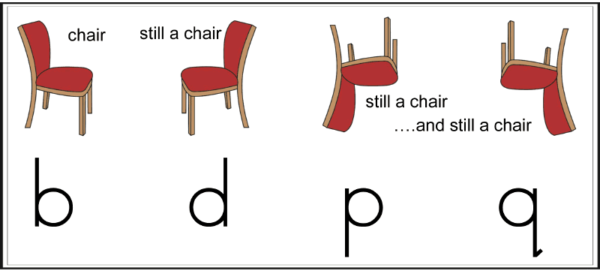お子様達が文字を左右反転(後ろ向き)に書いている事はありませんか?
当校Sam講師より、とっても興味深い内容の記事となります!
是非最後までお読み下さいませ♪

Before answering this disconcerting question that leaves many parents and teachers baffled.
Let me start by asking you a different question.
Would you recognize a coffee mug even if it’s turned backward?
What about a frog laying on its back?
An elephant standing on its trunk?
The answer would most likely be a YES. The reason is that our visual system converts what we see into distinguishable objects without taking into consideration their orientation as objects turn and rotate.
In other terms, our visual system can identify an object no matter what orientation that object is in.
お子様が覚えたてのアルファベット(ひらがな・カタカナ含む)を書く時、左右反転(後ろ向き)に書く事はありませんか?
多くの教師や保護者の方、「直さなきゃ!」「正しく書いてもらわなきゃ!」と思いますよね。
別の質問をしてみましょう。
コーヒーマグカップが後ろ向きになってもコーヒーマグカップと認識できますか?
背中にいるカエルはどうですか?
トランクの上に立っている象は?
答えは、おそらくYESでしょう。その理由は、視覚システムは、対象が回転する際の向きを考慮せずに、見たものを区別可能な対象に変換するためです。
この視覚システムは、その対象がどの方向にあるかにかかわらず、対象を識別できます。
There is an exception to this rule however “the letters of the alphabet”. Mirroring the letter “p” will turn it into a “q”, its reflection will be a “b” and the mirror of the reflection is a “d”. It is quite unnatural for us who are used to recognizing shapes regardless of their orientation.
In their early stages of learning, young students tend to write some letters backward. They might even write a whole word or a full sentence as if in a mirror.
The act of mirroring letters, although it is seen as a misstep that needs to be addressed,is an exceptional accomplishment. If you think about it, the children learned on their own to write backwards. Try to write a sentence backwards to see how difficult it is.
The reason behind that is that our brains process the letters at this stage as every other image. Which means q,p,b, or d will be considered equal by our visual system.
Children who are learning to read still function with a default setting in their visual systems. Part of the process of learning implies unlearning something very natural to them to learn to read and write.
この規則には例外がありますが、「アルファベットの文字」です。文字 “p” を鏡に映すと “q” になり、その(上下)反射は “b” になり、さらに鏡に映すと “d” になります。
その向きに関係なく、形状を認識することに慣れている私達にとっては、対象の向きによってその対象が別のものになるという考え方は非常に不自然です。

文字を学び始めてまもないお子様は後ろ向きに書く傾向があります。まるで鏡のように単語全体や文全体を後ろ向きに書くかもしれません。
文字を後ろ向きに書く事は、すぐにでも直さなければいけない“間違い”と思いがちですが、考えてみて下さい。お子様は自分で自ら後ろ向きに書く事を選んでいます。
あえて後ろ向きで書くという難しさを想像してみて下さい。
私たちの脳は、文字を認識する際、q、p、b、またはdは、私たちの視覚システムによるとすべて同じとみなされます。
読み書きを学んでいるお子様達は、視覚システムがまずは初期設定となっています。
学習のプロセスとしては、とっても自然な最初のステップです。
So the next time your children mirror a letter. Don’t be offended. Just marvel at their wonderful ability and give them the time to unlearn it. It might take time, but no need to worry about it. Children learn at their own pace.
If you are interested in this subject and want to learn more about it check [The Secret Life of the Mind: How Your Brain Thinks, Feels, Decides by Mariano Sigman.
これらの事から、お子様達が文字を後ろ向き(左右反転)に書いていたとしても、がっかりする必要は全くありません。
時間は少しかかるかもしれませんが、お子様は自分のペースで学びます。 もしこのテーマに興味があり、もっと学びたい場合は、
参考文献:
「The Secret Life of the mind: How Your Brain Thinks, Feels, Decides by Mariano Sigman」

